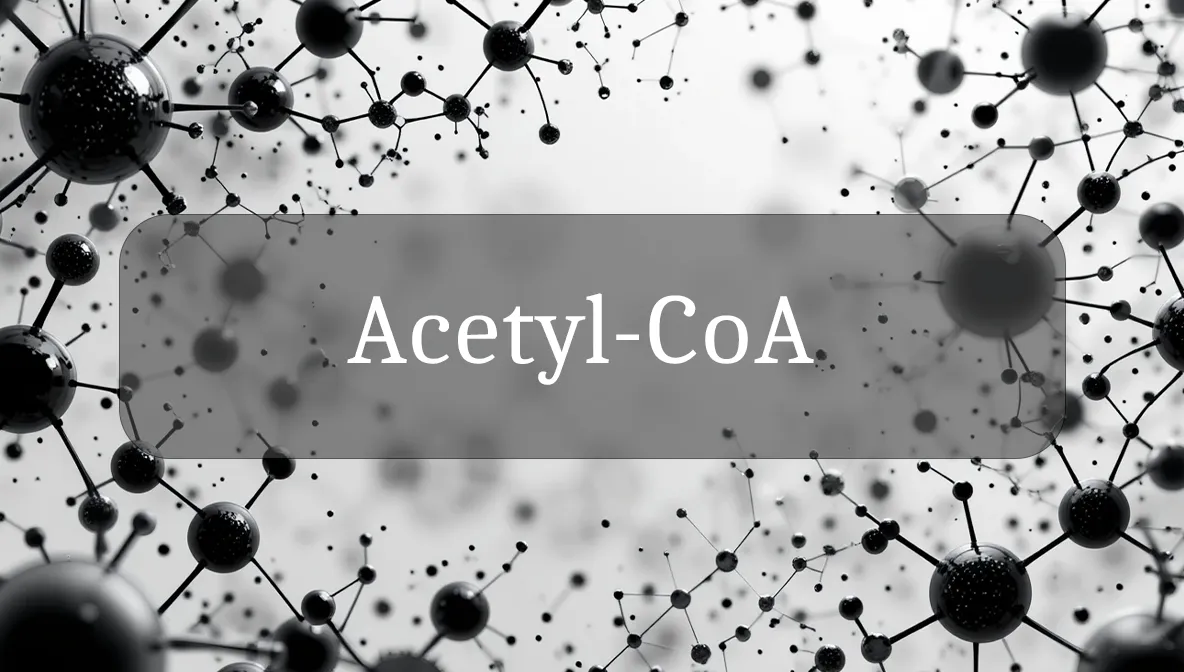Metabolic Fuel Hub for Energy and Building Blocks
Acetyl-CoA (Acetyl Coenzyme A) is like your body’s central energy switchboard, directing nutrients from food to power your cells or build essential molecules. This small but mighty molecule is a cornerstone of metabolism, keeping you energized and healthy. Let’s explore what Acetyl-CoA is, how it supports your wellness, and how to ensure your body has the tools to make it.
Chemical Identity and Type
Acetyl-CoA is a coenzyme, a molecule that works with enzymes to drive chemical reactions. It’s made up of an acetyl group (a two-carbon unit) bonded to Coenzyme A, which itself contains pantothenic acid (Vitamin B5). Acetyl-CoA is formed in your cells’ mitochondria (energy powerhouses) from the breakdown of carbohydrates, fats, or proteins, acting as a key intermediate in metabolism.
Biological Role and Benefits
Acetyl-CoA is a metabolic multitasker, delivering benefits that keep your body running smoothly:
- Energy Production: It feeds into the Krebs cycle (citric acid cycle) in mitochondria, generating ATP (your body’s energy currency) to fuel muscles, organs, and brain activity.
- Fatty Acid and Cholesterol Synthesis: Acetyl-CoA is used to build fats for energy storage or cell membranes and cholesterol for hormones and cell structure.
- Neurotransmitter Support: It helps produce acetylcholine, a neurotransmitter crucial for memory, muscle movement, and nerve signaling.
- Detoxification: Acetyl-CoA aids in liver detox processes, helping clear toxins and drugs from your system.
- Cellular Health: It supports the creation of molecules needed for cell growth, repair, and maintenance.
By powering energy and building essential compounds, Acetyl-CoA keeps you active, focused, and resilient.
Dietary or Natural Sources
Your body makes Acetyl-CoA from nutrients, primarily via pantothenic acid (Vitamin B5) and energy-yielding foods:
- Pantothenic Acid (B5) Sources (for Coenzyme A):
- Organ Meats: Liver and kidney (3 oz beef liver: ~8 mg B5).
- Meat and Poultry: Chicken and pork (3 oz chicken: ~1 mg B5).
- Fish: Salmon (3 oz: ~1.5 mg B5).
- Eggs: One large egg (~0.7 mg B5).
- Whole Grains: Oats and brown rice (1 cup oats: ~1 mg B5).
- Vegetables: Mushrooms and avocados (1 cup mushrooms: ~1 mg B5).
- Energy Nutrients (for acetyl group):
- Carbohydrates: Whole grains, potatoes, and fruits provide glucose.
- Fats: Nuts, olive oil, and fatty fish supply fatty acids.
- Proteins: Beans, meat, and dairy offer amino acids.
- Supplements: B5 (5–50 mg), B-complex vitamins, or multivitamins support Coenzyme A production. Acetyl-CoA itself isn’t supplemented.
A balanced diet with B5 and varied nutrients ensures Acetyl-CoA production.
Signs of Imbalance or Dysfunction
Acetyl-CoA imbalances are tied to nutrient deficiencies or metabolic issues:
- Low Acetyl-CoA (B5 or Nutrient Deficiency):
- Fatigue, low energy, or muscle weakness.
- Brain fog, irritability, or poor focus.
- Numbness or tingling in hands/feet (nerve issues).
- Digestive upset or poor appetite.
- Metabolic Dysfunction:
- Blood sugar swings or insulin resistance (impaired carb metabolism).
- Weight gain or difficulty burning fat (disrupted fat metabolism).
- Rare genetic disorders (e.g., pyruvate dehydrogenase deficiency) may impair Acetyl-CoA production, causing neurological or energy issues.
- Excess (Rare): Excess Acetyl-CoA is typically converted to fat storage, not harmful unless linked to overeating.
If you notice persistent fatigue, nerve issues, or metabolic symptoms, consult a doctor for nutrient or metabolic testing.
Supporting Optimal Levels or Function
To keep Acetyl-CoA thriving:
- Eat B5-Rich Foods: Include 1–2 servings of B5 sources daily (e.g., eggs, mushrooms). Adults need 5 mg pantothenic acid daily, easily met through diet.
- Balance Macronutrients: Consume carbs (whole grains), fats (nuts, fish), and proteins (beans, meat) to provide raw materials for Acetyl-CoA.
- Support Mitochondrial Health: Eat antioxidant-rich foods (berries, greens) and exercise (e.g., walking, strength training) to boost mitochondrial efficiency.
- Manage Stress: Chronic stress increases energy demands, straining Acetyl-CoA pathways. Try relaxation techniques like meditation or yoga.
- Supplements (If Needed): B5 or B-complex (10–50 mg B5) supports Coenzyme A, but most people get enough from food.
Consult a doctor if you suspect deficiencies or metabolic issues before supplementing.
Safety, Interactions, and Precautions
Acetyl-CoA and B5 are safe, with minimal risks:
- Medical Conditions: Malabsorption (e.g., Crohn’s, celiac) or diabetes may affect nutrient use for Acetyl-CoA production, requiring medical oversight.
- Medication Interactions: Some drugs (e.g., antibiotics, statins) may indirectly affect B5 levels or metabolism. Discuss with your doctor if on long-term meds.
- Allergies: Rare reactions (rash, nausea) can occur with B5 supplements. Use high-quality, tested products.
- Overnutrition: Excess carbs or fats can lead to Acetyl-CoA being stored as fat, so maintain a balanced diet.
Fun Fact
Did you know Acetyl-CoA is a universal metabolic “currency”? It’s so central to life that every living organism—from bacteria to humans—uses it to turn nutrients into energy or building blocks!
Citations
- National Institutes of Health (NIH): Pantothenic Acid Fact Sheet for Health Professionals.
- Mayo Clinic: B Vitamins and Metabolism.
- Cleveland Clinic: Mitochondrial Function and Coenzymes.
- Journal of Biological Chemistry: Acetyl-CoA in Energy Metabolism (2019).
- Harvard T.H. Chan School of Public Health: The Nutrition Source – B Vitamins.

